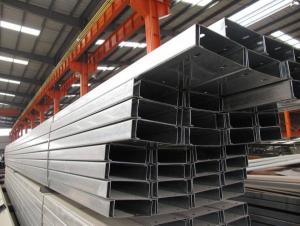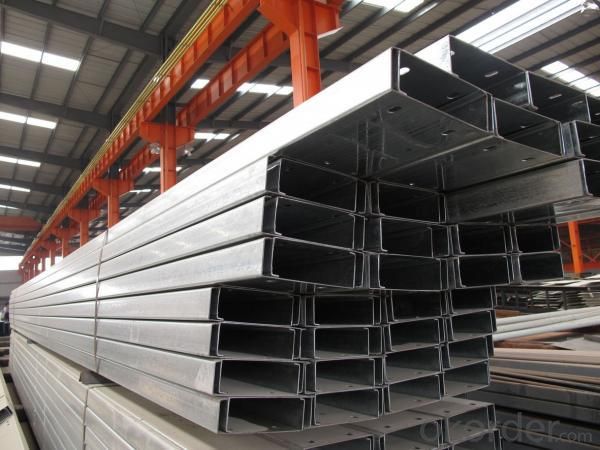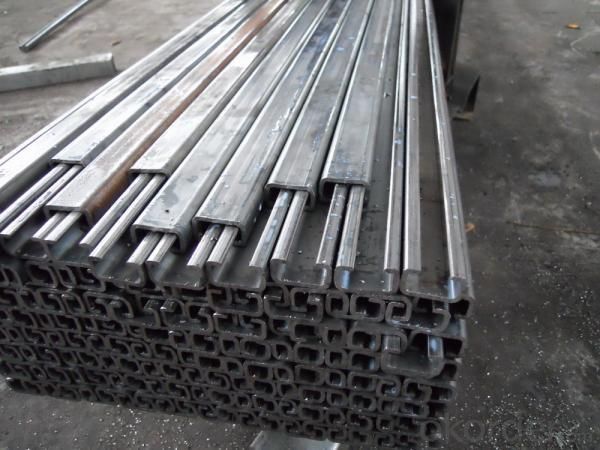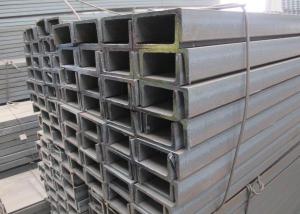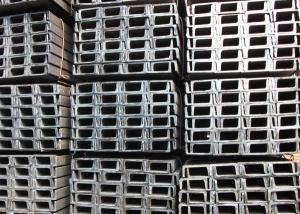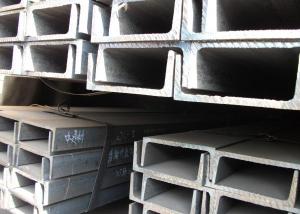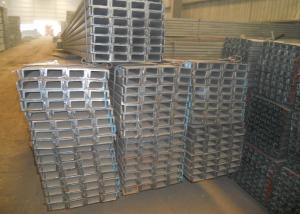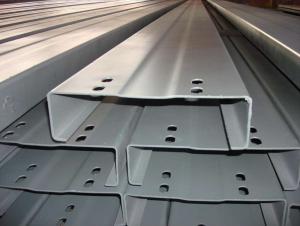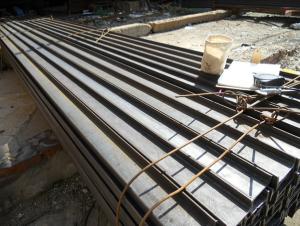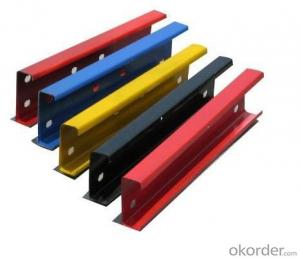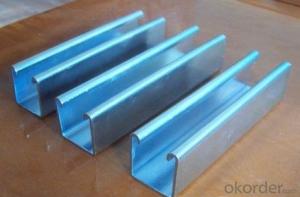Carbon Steel C Channel
- Loading Port:
- Tianjin Port,China
- Payment Terms:
- TT or LC
- Min Order Qty:
- 20 Tons m.t.
- Supply Capability:
- 100 Tons Per Day m.t./month
OKorder Service Pledge
OKorder Financial Service
You Might Also Like
Specifications of Carbon Steel C Channel:
1.We supply high quality Carbon Steel C Channel at reasonable price, including Chinese standard, Japanese standard and so on.
Standard | GB/JIS/EN/ASTM/DIN |
Material Grade | Q235B,Q235,Q345,Q345B,SS400,S235JRG1,A36,ST37-2 |
Technique: | Cold Rolled |
Sizes as per chinese standard: |
80×40×20×2.5 - 180×60×20×2.5
|
Sizes as per Japanese standard: |
180×60×20×3 – 300×80×20×3 |
Length: | 6meter, 9meter, 12meter |
Note: we are also competent to provide our customers other Carbon Steel C Channel based on other sizes according to customer’s requirements.
2. The detailed sections of MS C Channel Bar as per GB standard.Just as followings in the table-1:
Size | Weight(kg/m) | Size | Weight(kg/m) |
80×40×20×2.5 | 3.925 | 180×60×20×3 | 8.007 |
80×40×20×3 | 4.71 | 180×70×20×2.5 | 7.065 |
100×50×20×2.5 | 4.71 | 180×70×20×3 | 8.478 |
100×50×20×3 | 5.652 | 200×50×20×2.5 | 6.673 |
120×50×20×2.5 | 5.103 | 200×50×20×3 | 8.007 |
120×50×20×3 | 6.123 | 200×60×20×2.5 | 7.065 |
120×60×20×2.5 | 5.495 | 200×60×20×3 | 8.478 |
120×60×20×3 | 6.594 | 200×70×20×2.5 | 7.458 |
120×70×20×2.5 | 5.888 | 200×70×20×3 | 8.949 |
120×70×20×3 | 7.065 | 220×60×20×2.5 | 7.4567 |
140×50×20×2.5 | 5.495 | 220×60×20×3 | 8.949 |
140×50×20×3 | 6.594 | 220×70×20×2.5 | 7.85 |
160×50×20×2.5 | 5.888 | 220×70×20×3 | 9.42 |
160×50×20×3 | 7.065 | 250×75×20×2.5 | 8.634 |
160×60×20×2.5 | 6.28 | 250×75×20×3 | 10.362 |
160×60×20×3 | 7.536 | 280×80×20×2.5 | 9.42 |
160×70×20×2.5 | 6.673 | 280×80×20×3 | 11.304 |
160×70×20×3 | 8.007 | 300×80×20×2.5 | 9.813 |
180×50×20×2.5 | 6.28 | 300×80×20×3 | 11.775 |
180×50×20×3 | 7.536 | ||
180×60×20×2.5 | 6.673 |
Table-1
3. The chemical composition of MS C Channel Bar according to Q235B is shown in Table-2.
Alloy No | Grade | Element(%) | ||||
C | Mn | S | P | Si | ||
Q235 | B | 0.12-0.20 | 0.3-0.7 | ≦0.045 | ≦0.045 | ≦0.3 |
Table-2
Note: we are able to present our customers relevant SGS test report for chemical composition of Carbon Steel C Channel.
4. The mechanical property of Carbon Steel C Channel according to Q235B is shown in Table-3-1 and Table-3-2
Alloy No | Grade | Yielding Strength Point(Mpa) | |||
Thickness(mm) | |||||
≦16 | >16-40 | >40-60 | >60-100 | ||
≧ | |||||
Q235 | B | 235 | 225 | 215 | 205 |
Table-3-1
Alloy No | Grade | Tensile Strength(Mpa) | Elongation After Fracture(%) | |||
Thickness(mm) | ||||||
≦16 | >16-40 | >40-60 | >60-100 | |||
≧ | ||||||
G235 | B | 375-500 | 26 | 25 | 24 | 23 |
Table-3-2
Note: we are able to present our customers relevant SGS test report for mechanical property of MS C Channel Bar as customer’s request.
Applications of Carbon Steel C Channel:
The Carbon Steel C Channel Bar can be applied to construction of warehouses, workshops, sport stadiums and car parks etc.The hot rolled channel steel belongs to carbon structural steel which is applied to in the field of construction and machinery.In details, the hot rolled channel steel is usually used for arch-itechtural structure, and they could be welded in order to support or hang a vari-ety of facilities. They are also usually used in combination with I beam. Generally,the hot rolled channel steel we supply must possess perfect welding property, riveting property and mechanical property and so on.
Package & Delivery of Carbon Steel C Channel:
1.The hot rolled channel steel will be packed in bundle with steel wire at each end of every bundle and color marking in order to help the customer to recognize his goods more easily at sight.
2. And the hot rolled channel steel could be loaded into 20ft or 40ft container, or by bulk cargo.If the weight of each bundle reaches more than 3.5 mt, the loading by break bulk cargo should be choosed.When the weight of each bundle reaches less than 3mt, the loading by container should be choosed.
3.As for the transportaion from mill to loading port, the truck will be usually used. And the maximum quantity for each truck is 40mt.
4.All in all, we could do in accordance with customer's request.
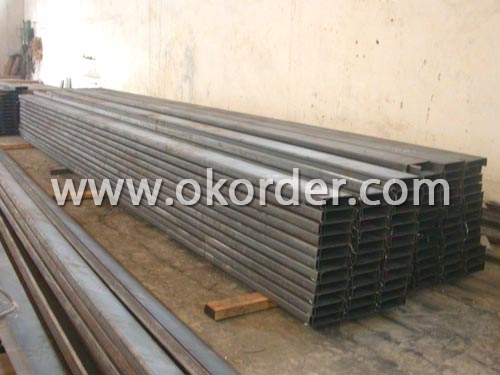
Production Flow of Carbon Steel C Channel:
1.The steel billet shall be heated in the high temperature furnace.
2. The heated steel billet shall be rolled five to nine times with the aim of shaping the general figure of steel u channel.
3. The hot rolled channel steel should be put onto the cooling bed to make the temperature low.
4. The channel steel should be straighted on the straightener.
5. The straighted channel steel will be cut into meters by saw, as per customer's requirements.
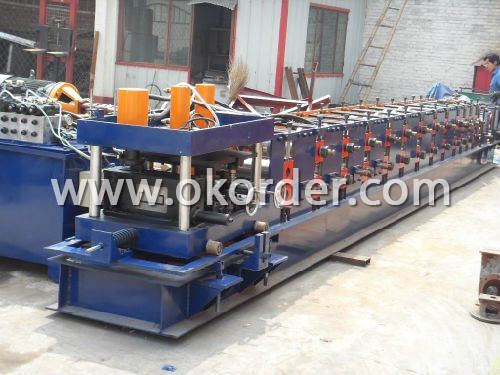
- Q: How are steel channels protected during transportation and storage?
- Steel channels are typically protected during transportation and storage through various measures. These include using appropriate packaging materials such as wooden crates or pallets to prevent physical damage and corrosion. Additionally, protective coatings or films are often applied to the steel channels to safeguard against moisture and rust. Proper handling and storing techniques, such as keeping them away from direct sunlight and extreme weather conditions, also play a crucial role in ensuring their protection.
- Q: Can steel channels be used for suspended ceilings?
- Certainly, suspended ceilings can utilize steel channels. Owing to their strength and durability, steel channels frequently find application in suspended ceiling systems. They serve as a sturdy foundation for ceiling tiles or panels and contribute to the creation of a flat and secure ceiling surface. Furthermore, steel channels possess resistance to fire, corrosion, and pests, rendering them an appropriate choice for suspended ceilings in diverse environments, including commercial buildings, offices, schools, and healthcare facilities. Moreover, the installation and adjustment of steel channels to accommodate varying ceiling heights and layouts is a straightforward process, making them an adaptable choice for suspended ceiling installations.
- Q: Can steel channels be used for railway track support?
- Yes, steel channels can be used for railway track support. They are commonly used as a structural component in railway track systems due to their strength, durability, and ability to provide stable support for the tracks.
- Q: How do steel channels contribute to the overall thermal insulation of a structure?
- The overall thermal insulation of a structure is not directly influenced by steel channels. Nevertheless, these channels can have a role in supporting and securing the insulation materials used for thermal insulation. Typically, insulation materials like foam boards or fiberglass are installed between the structural framing members of a building to decrease heat transfer. As part of the structural framework, steel channels can provide the necessary support for these insulation materials. Steel channels aid in preventing any movement or displacement of the insulation materials, which could compromise their effectiveness. Moreover, they can act as a barrier, safeguarding the insulation from compression or damage during construction or over time. Additionally, steel channels have the ability to create airtight seals around the edges of insulation materials. This helps to minimize air leakage and improve the overall thermal performance of the structure. To summarize, although steel channels do not contribute directly to thermal insulation, they are crucial in supporting and securing insulation materials, ensuring their effectiveness, and enhancing the overall thermal insulation of a structure.
- Q: What are the guidelines for steel channel installations in high-temperature environments?
- When it comes to installing steel channels in high-temperature environments, there are several guidelines that should be followed to ensure safety and optimal performance. These guidelines include: 1. Material Selection: Choose a steel channel that is specifically designed for high-temperature applications. The material should have high-temperature resistance, such as stainless steel, to prevent deformation or failure under extreme heat conditions. 2. Adequate Ventilation: Install steel channels in areas with proper ventilation to dissipate heat. This helps to prevent the accumulation of excessive heat, which can lead to structural damage or compromise the integrity of the installation. 3. Expansion Joints: Incorporate expansion joints in the steel channel system to allow for thermal expansion and contraction. High temperatures cause materials to expand, and without expansion joints, the steel channels may become stressed and potentially fail. 4. Proper Fixing and Support: Ensure that the steel channels are securely fixed and supported throughout the installation. This includes using appropriate brackets, fasteners, and supports that are capable of withstanding high temperatures. 5. Insulation: Consider using insulation materials to protect the steel channels from extreme heat and minimize heat transfer. Insulation can help maintain the structural integrity of the installation and prevent damage to surrounding components. 6. Regular Inspection and Maintenance: Regularly inspect the steel channel installation in high-temperature environments to identify any signs of damage, wear, or deformation. It is crucial to address any issues promptly to prevent potential failures or accidents. 7. Comply with Industry Standards: Adhere to relevant industry standards and regulations for steel channel installations in high-temperature environments. These standards provide specific guidelines and safety measures that should be followed to ensure a successful and safe installation. By following these guidelines, the installation of steel channels in high-temperature environments can be done with confidence, providing a durable and reliable solution for various applications.
- Q: Can steel channels be used for walkway supports?
- Yes, steel channels can be used for walkway supports. Steel channels, also known as C-channels, are commonly used in construction for their strength and durability. They provide a stable and reliable support structure for walkways, ensuring the safety of individuals walking on them. Steel channels can be easily installed and can withstand heavy loads and constant foot traffic, making them an ideal choice for walkway supports in various settings such as industrial plants, bridges, and outdoor walkways.
- Q: What are the different types of steel channel profiles?
- There are several different types of steel channel profiles, each designed for specific applications and structural needs. Some of the commonly used types include: 1. C Channel: This is a popular type of steel channel profile that has a C-shaped cross-section. It is often used in construction and engineering projects as a structural support or as a frame for various applications. 2. U Channel: Also known as a U-shaped channel, this type has a similar cross-section to the letter "U". It is commonly used in construction, manufacturing, and automotive industries for applications such as framing, bracing, and support. 3. Hat Channel: Hat channels have a distinctive hat-like shape, with a flat bottom and two vertical sides. They are often used in construction for applications such as ceiling and wall framing, as well as in the automotive industry for reinforcing structural components. 4. Box Channel: As the name suggests, box channels have a rectangular or square cross-section. They are frequently used in construction, manufacturing, and engineering projects where strength and rigidity are required. 5. Z Channel: Z channels have a Z-shaped cross-section, with two flanges on opposite sides and a center web connecting them. They are commonly used in construction for applications such as framing, support, and bracing, especially in roofing and cladding systems. 6. Lipped Channel: Lipped channels, also known as lip channels or lip sections, have an additional lip or flange along one side of the channel. This lip provides extra strength and rigidity, making it suitable for applications such as shelving, racking, and structural support. These are just a few examples of the different types of steel channel profiles available. The choice of profile depends on the specific requirements of the project, including load-bearing capacity, structural stability, and overall design considerations.
- Q: How many tons per ton for channel 12?
- 12# channel steel height 120 mm, leg width 53 mm, waist thickness 5.5 mm, 12.06 kg / m, specification: 6m. Around ton:1000 "(12.06 x 6) = 13.81=14.Theoretical weight calculation of channel steel: the theoretical weight of steel is calculated as kg (kg), and its basic formula is:W (weight kg) = F (basal area of mm * L (L) * P (length m) density of g/cm * 1/1000 (fand) steel dense fand 7.85g/cm)
- Q: How do steel channels contribute to the overall material efficiency of a structure?
- Steel channels contribute to the overall material efficiency of a structure by providing a high strength-to-weight ratio. Due to their shape and design, steel channels allow for the optimal utilization of materials, minimizing waste and reducing the amount of steel required to achieve the desired structural integrity. This efficiency not only promotes cost savings but also reduces the environmental impact of the construction process.
- Q: How do steel channels perform in high-seismic areas?
- Steel channels perform well in high-seismic areas due to their inherent strength and ductility. In seismic zones, the ground experiences intense shaking and lateral forces, which can cause buildings to undergo significant structural deformation. Steel channels, with their ability to flex and absorb energy, are better equipped to withstand these forces compared to other building materials. The shape of steel channels, with their flanges and web, provides enhanced strength and rigidity. This allows them to resist bending and twisting forces, ensuring the overall stability of structures in high-seismic areas. Furthermore, steel channels can be designed to have tapered flanges, which improves their load-carrying capacity and reduces the risk of buckling during seismic events. Another advantage of steel channels in high-seismic areas is their ability to dissipate energy. During an earthquake, the channel's flexible nature allows it to absorb and distribute the seismic forces, minimizing the impact on the structure. This energy absorption capability reduces the chances of structural damage and enhances the safety of occupants inside the building. Moreover, steel channels offer versatility in design and construction. They can be easily integrated into various structural systems, such as moment frames and braced frames, which are commonly used in earthquake-resistant buildings. This flexibility allows for efficient and cost-effective construction in high-seismic areas. Overall, steel channels provide reliable performance in high-seismic areas by offering strength, flexibility, and energy dissipation capabilities. Their ability to withstand intense shaking and lateral forces makes them a preferred choice for structural applications in seismic zones, ensuring the safety and resilience of buildings in such areas.
1. Manufacturer Overview
| Location | Tianjin,China |
| Year Established | 2006 |
| Annual Output Value | Above US$ 500 Million |
| Main Markets | China; Middle East; Southeast Asia; South America |
| Company Certifications |
2. Manufacturer Certificates
| a) Certification Name | |
| Range | |
| Reference | |
| Validity Period |
3. Manufacturer Capability
| a) Trade Capacity | |
| Nearest Port | Tianjin |
| Export Percentage | 40%-60% |
| No.of Employees in Trade Department | 11-20 People |
| Language Spoken: | English; Chinese |
| b) Factory Information | |
| Factory Size: | Above 50,000 square meters |
| No. of Production Lines | Above 3 |
| Contract Manufacturing | materials for processing; OEM Service Offered |
| Product Price Range | Average |
Send your message to us
Carbon Steel C Channel
- Loading Port:
- Tianjin Port,China
- Payment Terms:
- TT or LC
- Min Order Qty:
- 20 Tons m.t.
- Supply Capability:
- 100 Tons Per Day m.t./month
OKorder Service Pledge
OKorder Financial Service
Similar products
Hot products
Hot Searches
Related keywords
